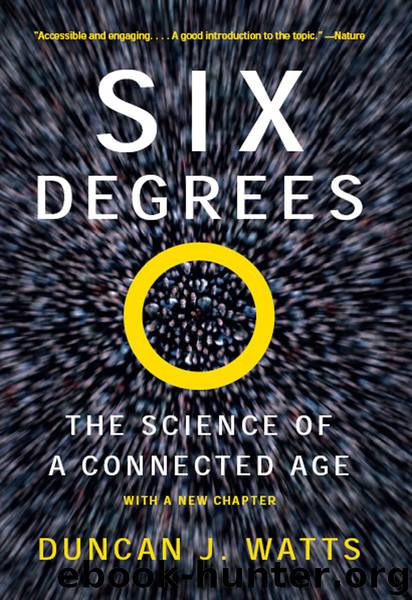Six Degrees by Duncan J. Watts

Author:Duncan J. Watts
Language: eng
Format: mobi
Publisher: Harlequin
Published: 2004-01-08T21:00:00+00:00
NETWORKS, VIRUSES, AND MICROSOFT
THIS RESULT WAS A PROMISING START AND DEMONSTRATED THAT for some problems at least, epidemics can be better understood by using a percolation approach than with the standard SIR model. Unfortunately, percolation on realistic networks is a difficult (and unsolved) problem, and further progress proved hard to come by. To keep the analysis manageable, for example, most percolation models either assume that all sites in the network are susceptible, and focus on the bonds (this is called bond percolation), or assume that all bonds are open, and focus on the sites (site percolation). Roughly the same methods work for both kinds of percolation, and in many respects, they behave in a similar fashion. Mark and I, for instance, studied the site percolation version, but shortly thereafter, Mark and another Santa Fe physicist, Cris Moore, extended the results to bond percolation. In some respects, however, site and bond percolation differ significantly, occasionally yielding quite different predictions for the likelihood of an epidemic.
Before racing ahead with the analysis, therefore, one has to think carefully about which version—bond percolation or site percolation—best captures the nature of the disease in question. In the case of a virus like Ebola, for example, it seems reasonable to assume that all people are susceptible, and to focus on the extent to which they can infect each other. Therefore, the relevant formulation of an Ebola-related percolation problem would be bond percolation. Computer viruses like the Melissa bug, however, will generally pass between any susceptible computer and any other computer (all bonds are effectively open), but not all computers are susceptible. So a percolation model of a computer virus probably ought to be of the site percolation variety. Taking the Melissa bug as an example, only a certain fraction of computers in the world are susceptible to the virus because it can only spread via the Microsoft Outlook e-mail program, and not everybody uses Outlook.
Unfortunately for Microsoft users, so many computers run Outlook that the largest connected cluster of them almost certainly percolates. If it didn’t, in fact, we wouldn’t see global viral outbreaks like Melissa and its protégés, the Love Letter and Anna Kournikova viruses. Universal software compatibility clearly confers some significant benefits on individual users. But from the perspective of system vulnerability, when everybody has the same software, everybody also has the same weaknesses. And every piece of software has weaknesses, especially large, complex operating systems like Microsoft’s. In a way, the only amazing thing about Melissa-style outbreaks is that they haven’t happened more often. And if they do start to happen more often—if Microsoft software acquires the reputation for persistent vulnerability—then large corporations, and even individuals who cannot afford to have their computers put out of action every time a new virus appears anywhere in the world, may start to look for alternatives.
What should Microsoft do? The obvious approach is to make its products as resilient as possible to attack by any wormlike virus, and in the event of an outbreak, make antivirus software available as quickly as possible.
Download
This site does not store any files on its server. We only index and link to content provided by other sites. Please contact the content providers to delete copyright contents if any and email us, we'll remove relevant links or contents immediately.
The Complete Stick Figure Physics Tutorials by Allen Sarah(7337)
Secrets of Antigravity Propulsion: Tesla, UFOs, and Classified Aerospace Technology by Ph.D. Paul A. Laviolette(5332)
Thing Explainer by Randall Munroe(3909)
The River of Consciousness by Oliver Sacks(3572)
The Order of Time by Carlo Rovelli(3162)
How To by Randall Munroe(3074)
A Brief History of Time by Stephen Hawking(2991)
I Live in the Future & Here's How It Works by Nick Bilton(2960)
What If?: Serious Scientific Answers to Absurd Hypothetical Questions by Randall Munroe(2667)
The Great Unknown by Marcus du Sautoy(2662)
Midnight in Chernobyl by Adam Higginbotham(2515)
Blockchain: Ultimate Step By Step Guide To Understanding Blockchain Technology, Bitcoin Creation, and the future of Money (Novice to Expert) by Keizer Söze(2467)
Networks: An Introduction by Newman Mark(2382)
The Meaning of it All by Richard Feynman(2318)
Easy Electronics by Charles Platt(2308)
The Tao of Physics by Fritjof Capra(2247)
Midnight in Chernobyl: The Untold Story of the World's Greatest Nuclear Disaster by Adam Higginbotham(2195)
When by Daniel H Pink(2098)
Introducing Relativity by Bruce Bassett(2097)
